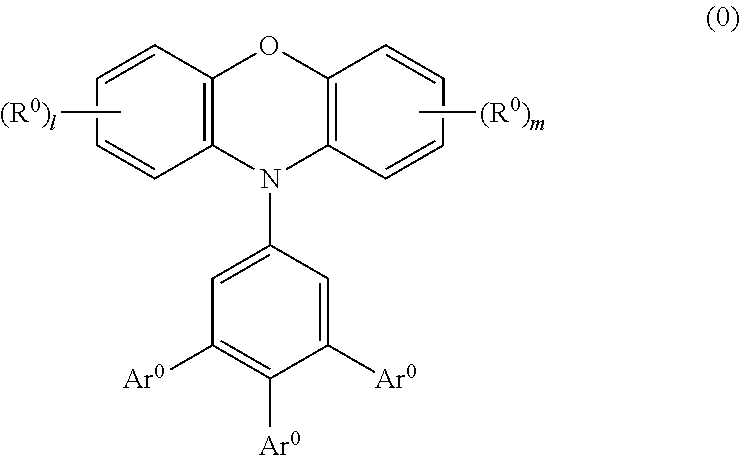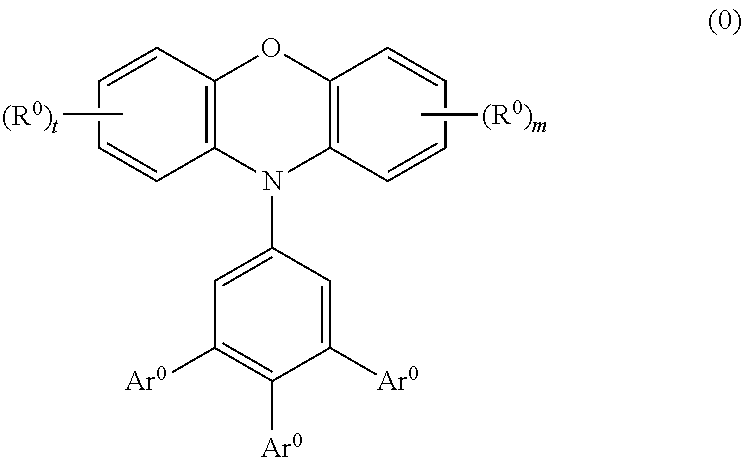Phenoxazine polymer compound and light emitting device using the same
a technology of phenoxazine and polymer compound, which is applied in the direction of luminescent compositions, thermoelectric devices, organic chemistry, etc., can solve the problem that the above-described polymer compound does not necessarily have sufficient chromatic purity, and achieve excellent chromatic purity
- Summary
- Abstract
- Description
- Claims
- Application Information
AI Technical Summary
Benefits of technology
Problems solved by technology
Method used
Image
Examples
example 1
Synthesis of Compound A
[0154]Synthesis of Compound A-1
[0155]Into a 500 ml three-necked flask was charged 9.59 g of 3,5-dibromophenol, 30.89 g of 3,5-bis(4-tert-butylphenyl)phenylboric acid (synthesized according to a method described in JP-A No. 2005-82730) and 95 g of tetraethyl ammonium hydroxide (20 wt % aqueous solution, 129 mmol), then, an atmosphere in the flask was purged with nitrogen. To this was added 215 ml of toluene and 0.15 g (0.22 mmol) of dichlorobis(triphenylphosphine)palladium, and the mixture was heated at 100° C. for 8 hours. Thereafter, the mixture was left to cool, to find deposition of a crystal. This crystal was dissolved by adding 1 L of chloroform, and the resultant solution was acidified by adding 1N hydrochloric acid, and separated. The resultant aqueous phase was extracted with 500 ml of chloroform, and chloroform after extraction was combined with the organic phase, and this was washed with water and saturated aqueous solution of sodium chloride. The or...
example 2
Synthesis of Polymer Compound 1
[0186]Under a nitrogen atmosphere, 0.40 g of 2,7-bis(1,3,2-dioxaborolan-2-yl)-9,9-di-n-octylfluorene (synthesized according to a method described in JP-A No. 2007-70620), 0.82 g of the compound A, 2.8 mg of dichlorobis(triphenylphosphine)palladium, 0.52 g of trioctylmethyl ammonium chloride (manufactured by Aldrich, trade name: Aliquat 336) and 15 ml of toluene were mixed, and the mixture was heated at 90° C. Into the resultant mixed solution, 5 ml of a 17.5 wt % sodium carbonate aqueous solution was dropped, and the mixture was refluxed for 6 hours. After the reaction, to this was added 0.1 g of phenylboric acid, and the mixture was further refluxed for 4 hours. Then, to this was added 5 ml of a 12.5 wt % sodium diethyldithiacarbamate aqueous solution, and the mixture was stirred at 85° C. for 2 hours. After cooling, the mixture was washed with 10 ml of water twice, with 10 ml of a 3 wt % acetic acid aqueous solution twice and with 10 ml of water twic...
example 3
Synthesis of Compound B
[0190]Synthesis of Compound B-1
[0191]An atmosphere in a 100 ml three-necked flask was purged with nitrogen, then, 3,5-dibromo-toluene (4.90 g) was charged therein, and dissolved in 22 ml of THF. The solution was cooled down to −78° C., and hexyllithium (8.5 ml, 2.3M hexane solution) was added over a period of 3 minutes. The mixture was stirred for 1 hour, then, 3.00 ml of 1-bromohexane was added over a period of 1 minute and the mixture was heated slowly. After heating up to room temperature, the mixture was cooled down to 0° C., and a saturated ammonium chloride aqueous solution (30 ml) was added to stop the reaction. After separation, the aqueous phase was extracted with toluene (30 ml). The organic phase was mixed in, and the mixture was washed with water (30 ml) and saturated aqueous solution of sodium chloride (30 ml). The organic phase was dried over anhydrous magnesium sulfate, then, filtrated, and the solvent was distilled off, to obtain 7.69 g of a cr...
PUM
| Property | Measurement | Unit |
|---|---|---|
| temperature | aaaaa | aaaaa |
| boiling point | aaaaa | aaaaa |
| temperature | aaaaa | aaaaa |
Abstract
Description
Claims
Application Information
 Login to View More
Login to View More - R&D
- Intellectual Property
- Life Sciences
- Materials
- Tech Scout
- Unparalleled Data Quality
- Higher Quality Content
- 60% Fewer Hallucinations
Browse by: Latest US Patents, China's latest patents, Technical Efficacy Thesaurus, Application Domain, Technology Topic, Popular Technical Reports.
© 2025 PatSnap. All rights reserved.Legal|Privacy policy|Modern Slavery Act Transparency Statement|Sitemap|About US| Contact US: help@patsnap.com



